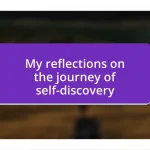Key takeaways:
- Backstory adds depth to characters, influencing their motivations, relationships, and conflicts, thus enhancing narrative tension and reader engagement.
- Effective integration of backstory involves using subtle reveals, sensory details, and character actions rather than large exposition dumps, ensuring it flows naturally within the story.
- Refinement of backstory requires critical evaluation of details, seeking feedback from others, and ensuring that every aspect serves a purpose in enriching the character’s journey.
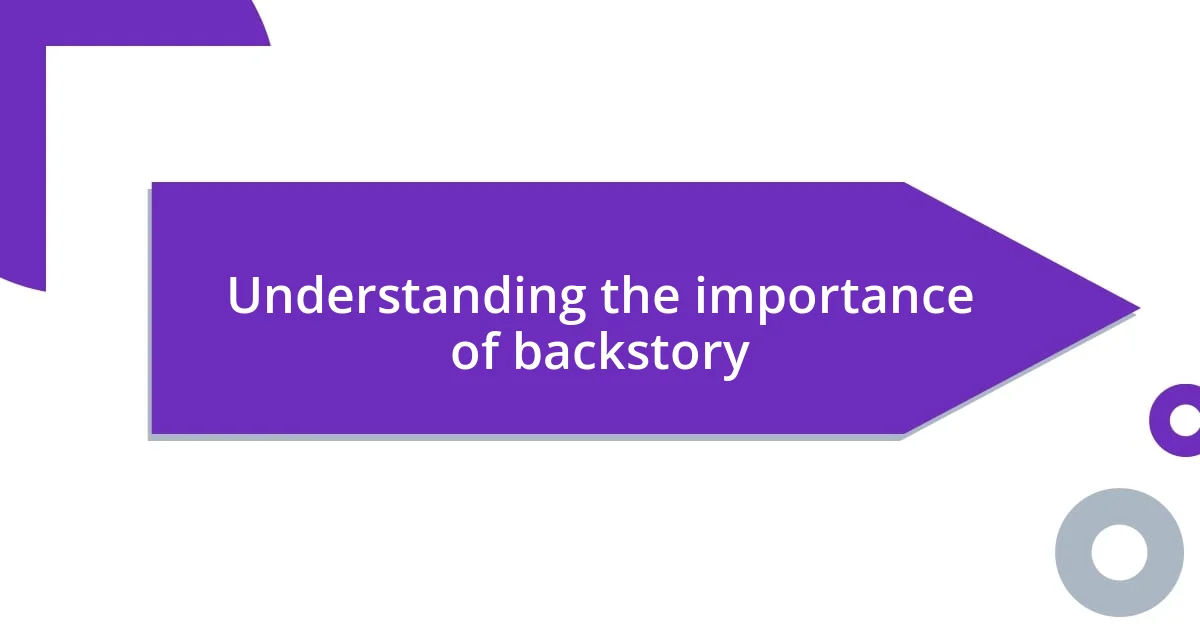
Understanding the importance of backstory
Backstory is crucial because it adds layers to a character, making them relatable and multidimensional. I remember creating a character who appeared tough on the outside, but once I delved into their childhood experiences, I uncovered vulnerabilities that resonated with readers. Don’t you think it’s our shared experiences that connect us to one another?
Understanding a character’s past not only informs their present actions but also shapes their future choices. For instance, I once crafted a character who struggled with trust issues because of betrayal in their youth. This backstory not only influenced their relationships in the story but also allowed me to explore themes of forgiveness and growth.
Moreover, backstory can serve as a powerful tool for controlling the narrative trajectory. Consider the impact of a character with a traumatic past; their decisions can be set on a collision course with their history. Isn’t it fascinating how those elements of the past can create tension and propel the plot forward?
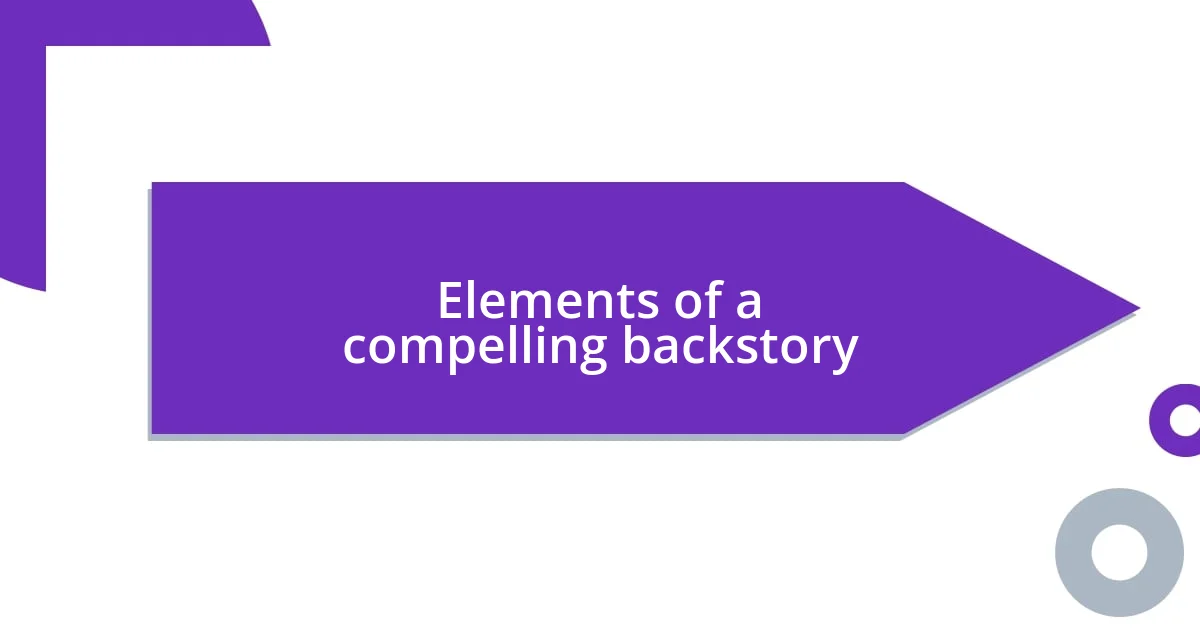
Elements of a compelling backstory
Creating a compelling backstory hinges on several vital elements. First and foremost, character motivation plays a significant role. I once designed a character with a seemingly trivial fear of water, but as I crafted their backstory, I revealed a traumatic drowning incident from their childhood. This not only explained their fear but added depth, allowing readers to empathize with their struggle. Isn’t it interesting how even small motivations can transform a character from flat to complex?
Another critical element is the influence of external relationships. Perhaps you’ve noticed that characters often reflect their past interactions with family or friends. I’ve found that weaving in a backstory involving a strained parental relationship can illuminate why a character behaves a certain way in present scenarios. This kind of detail can create layers, making readers think more deeply about how past interactions shape an individual’s identity and choices.
Lastly, conflict within the backstory injects excitement and tension. For instance, I created a protagonist whose life was uprooted by a family scandal that forced them into a new world. The lingering effects of that scandal fueled their internal conflicts throughout the main story. It’s remarkable how such backstory elements can not only engage readers but also make them eager to uncover how these conflicts will unfold.
| Element | Description |
|---|---|
| Character Motivation | Reasons behind a character’s actions, often tied to past experiences or fears. |
| External Relationships | Interactions with family and friends that shape a character’s behavior and decisions. |
| Conflict | Challenges from the past that create tension and affect character development. |
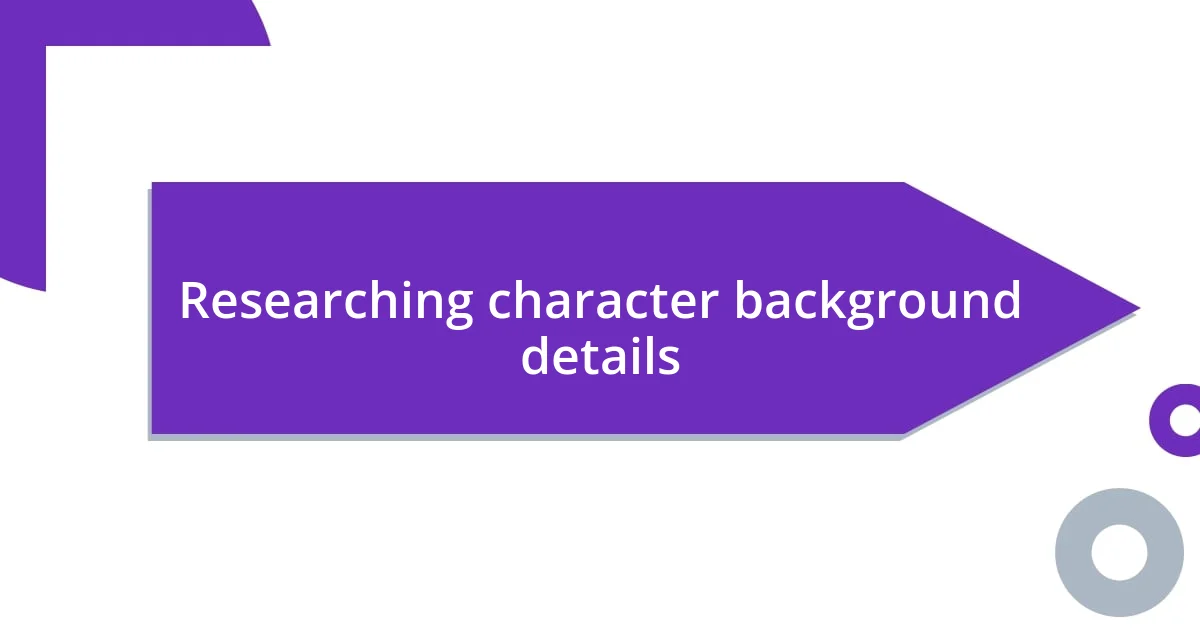
Researching character background details
Researching a character’s background can be an enlightening journey. I often find that immersing myself in the time period and culture of my character helps unveil details I hadn’t initially considered. For instance, while writing about a character from the 1960s, I dove into the societal norms and music of the era, feeling a deeper connection and understanding of their motivations and struggles. It’s incredible how details can influence the essence of who they are.
To make sure I’m capturing the right backstory details, I typically focus on several key areas:
-
Historical Context: Understanding the time period can unveil societal pressures that shaped a character’s outlook.
-
Cultural Influences: Exploring different cultural backgrounds enriches a character’s perspective and actions.
-
Personal Experiences: Reflecting on how your own experiences or those of people you know can inspire authentic details.
-
Interviews and Biographies: Sometimes, learning about real individuals can spark ideas that breathe life into your characters.
-
Setting Research: The environment a character grows up in plays a crucial role; visiting places or viewing images can evoke emotional insights.
In my own experience, digging into these areas not only bolsters the authenticity of my characters but often leads to unexpected revelations. It’s like peeling back layers, exposing the essence of who they are.
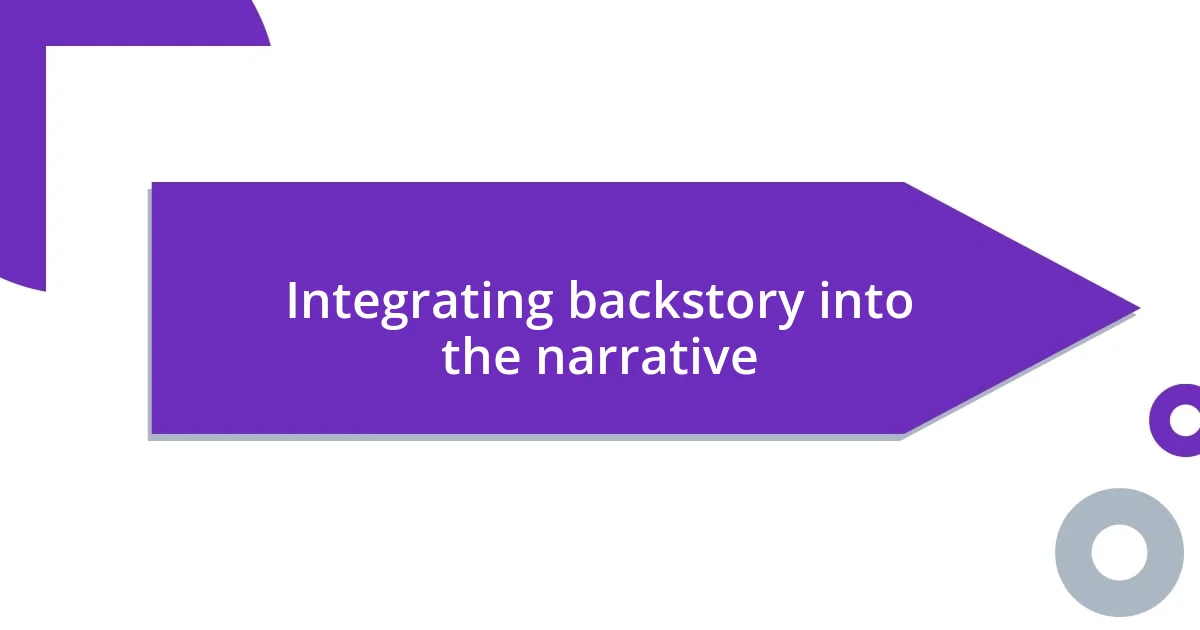
Integrating backstory into the narrative
Integrating backstory into the narrative is where the real magic happens. I remember a time when I introduced a character’s pivotal moment—a childhood loss—through a flashback. This method not only broke up the narrative but also drew readers into the emotional landscape of my character’s mind. Don’t you think that revealing a character’s pain in a visceral way makes their journey more relatable?
One technique I’ve found effective is to sprinkle backstory throughout dialogue. During a heated argument, I’ve had characters reference past events in a way that feels natural and organic. It’s surprising how these snippets can add layers to both the conversation and the characters, making readers feel like they’re privy to a history that shapes their present. Have you ever noticed how a well-placed backstory moment in dialogue can instantly make a scene more robust?
I also love weaving the backstory into the character’s decisions. For example, I crafted a scene where a character hesitates to trust someone due to a betrayal from their past. This choice not only drives the plot forward but also reinforces the character’s growth and vulnerabilities. I believe this kind of integration keeps readers engaged, as they begin to see how the past is not just a backstory but a living part of the character’s current journey. Doesn’t it feel more authentic when every action has roots in a character’s history?
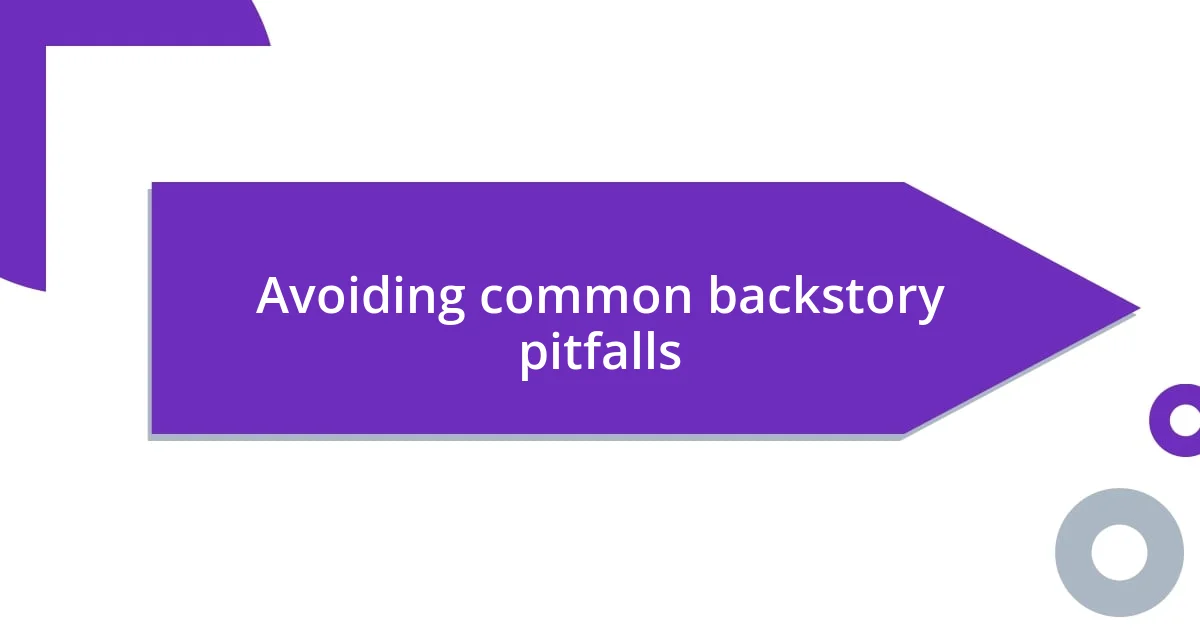
Avoiding common backstory pitfalls
When crafting a backstory, I’ve found it crucial to avoid overwhelming readers with too much information at once. One of my early mistakes was info-dumping all of a character’s history in a single exposition-heavy paragraph. It felt clunky and disengaging. Instead, I learned to unwrap the backstory like gifts. With each chapter, I reveal bits and pieces, letting readers discover the character’s past in a way that feels like an intriguing treasure hunt. Have you ever experienced a story where the backstory seemed to halt the momentum? It’s frustrating, isn’t it?
Another pitfall I’ve noticed is creating a backstory that feels disconnected from the main narrative. Early in my writing journey, I peppered in fascinating tidbits about a character’s past, only to realize later they didn’t resonate with the storyline. Now, I regularly assess how each piece of backstory feeds into the character’s motivations and actions in the present. It’s like ensuring every note in a song harmonizes with the overall melody. Does your backstory serve the narrative? It’s worth asking that question continuously.
Lastly, I urge fellow writers to avoid cliched backstories that feel too familiar or predictable. Early on, I leaned heavily on the “tragic past” trope without considering how it might play out in a unique way for my character. I’ve since made it a point to think outside the box, drawing from real-life experiences and unique settings to shape my characters’ histories authentically. Don’t you want your characters to surprise readers, keeping them invested and guessing? Embracing originality in backstory can make all the difference in capturing your audience’s attention.
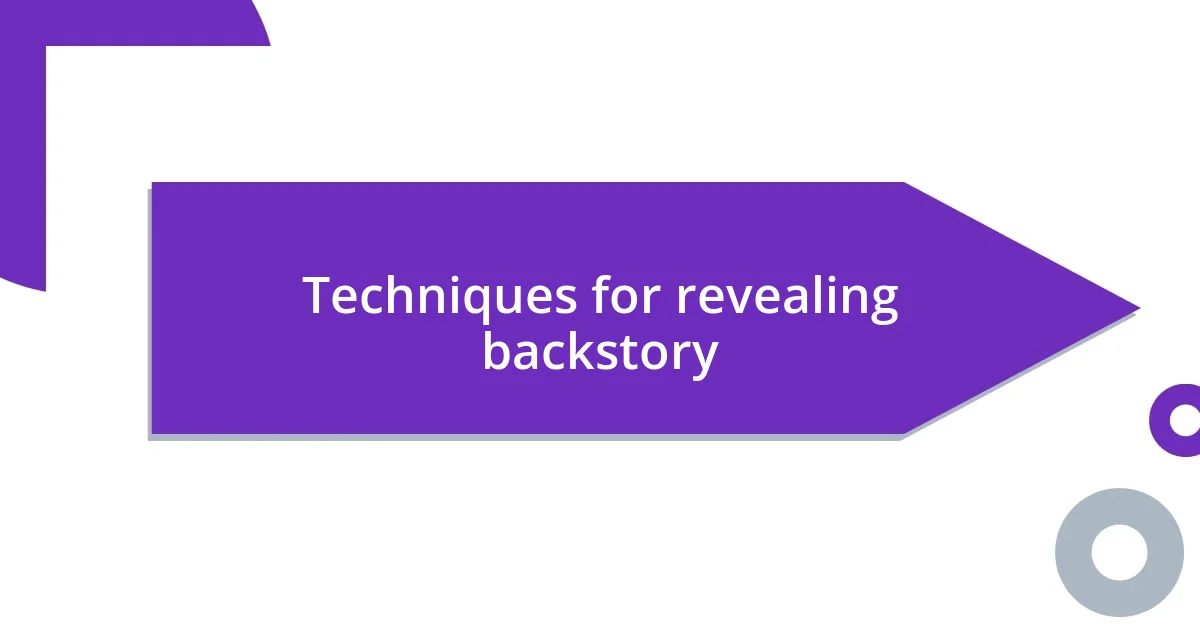
Techniques for revealing backstory
Revealing backstory effectively can sometimes hinge on subtlety. I recall a scene where a character casually mentioned a family heirloom in conversation, only for that heirloom to later play a crucial role in the plot. It was such a rewarding moment for the readers because they suddenly connected dots they hadn’t noticed before. Isn’t it fascinating how a seemingly small detail can transform the overall narrative landscape?
Another powerful technique I’ve employed is the use of sensory details. While writing about a character’s childhood home, I described the smell of fresh bread that filled the air, immediately transporting readers to a time of comfort and warmth. This not only painted a vivid picture but also tugged at emotions tied to childhood memories. Isn’t it amazing how the senses can evoke deeper feelings and understanding of a character’s background?
Lastly, I always find it rewarding to show rather than tell. In one of my stories, I opted for a scene where a character flinched at the sound of a door slamming, hinting at a tumultuous past without needing lengthy exposition. This approach not only engages the reader but creates a sense of intrigue, encouraging them to piece together the character’s backstory. Have you noticed how these small, impactful moments can resonate more deeply than pages of backstory? It’s all about letting the audience in on the journey of discovery.
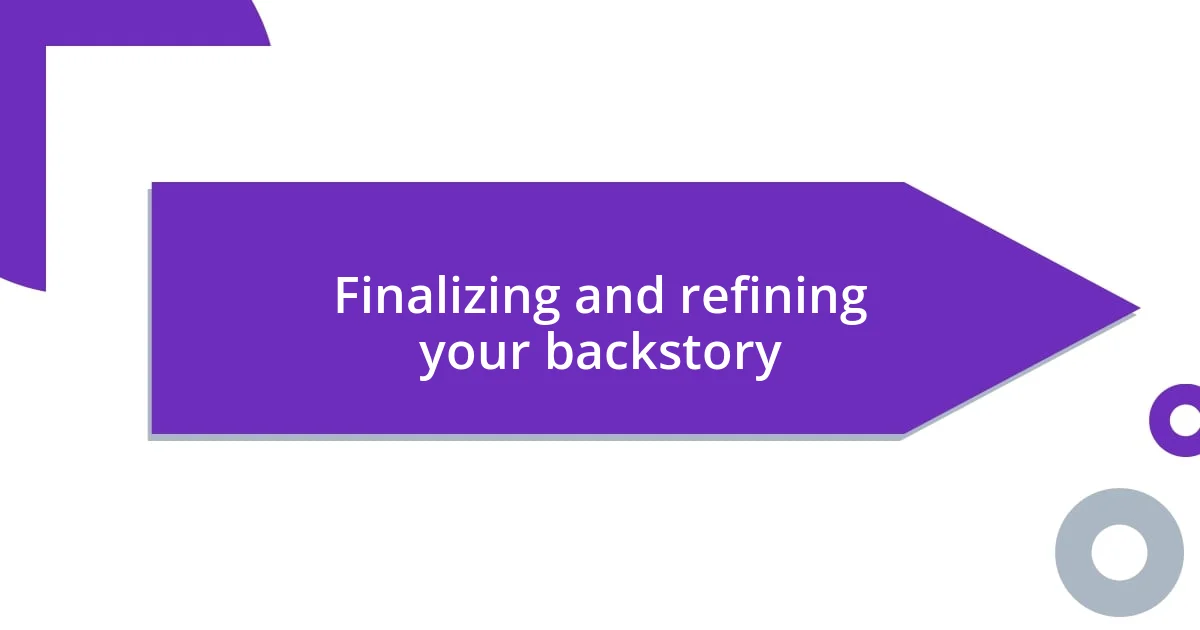
Finalizing and refining your backstory
Refining your backstory is an enlightening process that requires keen observation and flexibility. I remember the moment when I realized that a minor detail I had woven into my character’s narrative added unexpected depth. It was a simple childhood nickname that turned into a significant theme throughout the story, reflecting both vulnerability and growth. Have you ever stumbled upon a gem of insight while refining your own work? It’s moments like these that can elevate a backstory from average to captivating.
As I finalize my backstory, I often revisit my notes and character sheets, asking myself if each detail serves a purpose. It’s like trimming a garden; I cut away what feels overgrown or unnecessary. During one draft, I had a long monologue recounting a character’s past failures, but once I stepped back, I realized that much of it wasn’t crucial to the current arc. It was a liberating moment to let go of what didn’t add value, allowing for a cleaner, more impactful narrative. Have you ever held onto a section of your writing only to realize it might be weighing down your story?
Moreover, feedback from trusted readers is invaluable at this stage. I recall sharing my draft with a writing group and receiving their thoughts on my character’s motivations. They pointed out areas that needed clarification. Their fresh perspectives were often eye-opening. How often do you seek outside opinions? Sometimes, it takes another set of eyes to highlight the strengths and weaknesses we might overlook, helping craft a backstory that resonates with authenticity and clarity.





